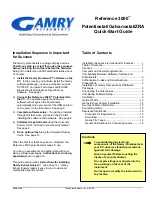
5. Making Conventional Measurements
Page
82
PHASOR
XS
Operating
Manual
5.17.1 Recording the JISDAC Curve
JISDAC Curve points are typically taken from a standard
with equally sized reflectors (holes) located at various
material depths. The primary echo from each of these
points (for up to a total of 15 echoes) are recorded. When
JISDAC is active, the instrument displays a line that
represents echo peaks for constant reflectors at varying
material depth. This line is drawn as either a curved (lin-
ear in gain) line based on a series of collected JISDAC
points or a series of straight line segments that join these
JISDAC points. Only one JISDAC curve can be stored at
a time. To program the JISDAC Curve:
Step 1:
Access the JISDAC menu by pressing
below it.
The RECORD Submenu will be selected (
Figure 5-13
).
Step 2:
Couple the probe to the first reference point and
adjust the A-Gate so that it is broken by the primary echo.
If necessary, use the Gain Knob to adjust the gain so
that the echo crosses the A-Gate and the highest peak in
gate A is at approximately 80% of full-screen height. The
highest peak must not be higher than 100% full-screen
height.
NOTE:
The AUTO 80 function allows for automatic
application of gain to set A-Gate’s triggering echo to
80% of full screen height. Press
to select AUTO
80 (located in the RECORD Submenu), then press
and hold it again. This function can also be accessed
at any time via the knob emulator menu (activated by
pressing
).
Step 3:
While the Gate is lined up over the first reference
echo, press
next to the RECORD function. When the
value of the RECORD function changes from 0 to 1, you
have recorded the first JISDAC Curve point. Note that the
first JISDAC point is treated as the reference echo. The
amplitude value at which this point is recorded becomes
the “reference amplitude” value.
NOTE:
When the first JISDAC reference point is stored,
two measurement result boxes will be automatically set
(if not already configured) to display SA and A%A
values.
Step 4:
Continue to record additional Curve points, follow-
ing steps 2 and 3, up to a maximum of 15 points (note that
at least two JISDAC Curve points are required).
Step 5:
When complete press
next to FINISH.
5.17.2 Working with DAC
In JISDAC mode the instrument uses the user-input refer-
ence points to create a curve representing the amplitudes
of echoes representing same-size reflectors at varying
material depth (
Figure 5-14
). To turn JISDAC evaluation
mode ON or OFF:
Step 1:
With the JISDAC Menu accessed, select the
SETUP submenu.
Step 2:
Press
next to the JISDAC function to select
ON or OFF. The JISDAC Curve will appear whenever
turned ON.
Interpreting JISDAC Lines and Classes
The JISDAC display contains a recorded reference line
and five fixed offset lines. Three of the lines are labeled
as follows:
H Line – Connects the recorded reference points
M Line – Fixed offset positioned 6 dB below the H line
L Line – Fixed offset positioned 12 dB below the H line
Any one of these three lines can be identified as the
reference from which measurements are based (see the
BOLD LINE function below). In addition, the remaining
three offset lines are drawn at 6, 12, and 18 dB above
the H line.
The regions of the A-Scan display bordered by the H, M,
and L lines are identified with JIS Class numbers. These
identifying numbers, shown in
Figure 5-14
as Roman
numerals, can also be displayed as results (see the CLS
result in
Figure 5-14
). CLS reports the region that contains
the peak of the A-Gate triggering echo.
Defining a BOLD LINE Measurement Reference
(JISDAC-SETUP-BOLD LINE)
The user-defined measurement reference is selected as
follows:
Step 1:
Access the SETUP Submenu (located in the
JISDAC Menu).
Step 2:
Press
next to the BOLD LINE function to select
the H, M, or L line.
Step 3:
Note that the selected line is now shown in bold
on the A-Scan display. This line now serves as the refer-
ence level from which all reference measurements (such
as A%rA or dBrB) are made.
Setting TRANSFER CORRection
(JISDAC-MAT ATTN-TRANSFER CORR)
The TRANSFER CORR function applies dB compensa-
tion for the difference in coupling conditions between the
known standard and the test piece.
Step 1:
Access the MAT ATTN Submenu (located in the
JISDAC Menu).
Содержание Phasor 16/16
Страница 6: ...Contents Page 4 PHASOR XS Operating Manual ...
Страница 16: ...1 Phased Array Operation Keypad Menus and Displays Page 14 PHASOR XS Operating Manual ...
Страница 24: ...2 Setting Up for Phased Array Measurement Page 22 PHASOR XS Operating Manual ...
Страница 45: ...3 Operating in Phased Array Mode PHASOR XS Operating Manual Page 43 FIGURE 3 9 TCG Recording Process ...
Страница 86: ...5 Making Conventional Measurements Page 84 PHASOR XS Operating Manual ...
Страница 92: ...6 Storing Data Sets and Generating Reports Page 90 PHASOR XS Operating Manual ...
Страница 96: ...7 Technical Specifications Page 94 PHASOR XS Operating Manual ...
















































